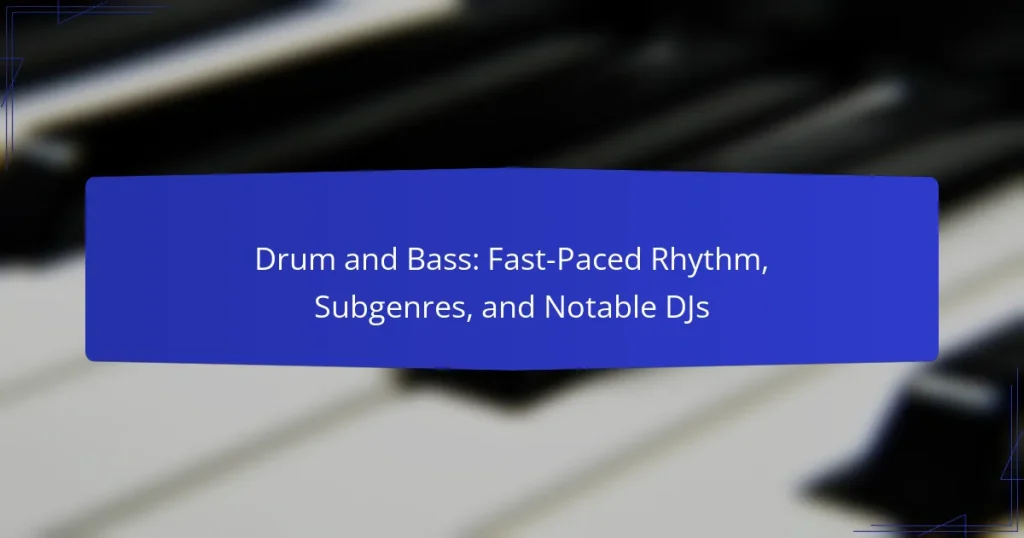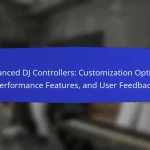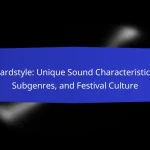Drum and Bass is a genre of electronic music known for its fast breakbeats and heavy basslines, originating in the UK in the early 1990s. The genre typically features tempos ranging from 160 to 180 beats per minute and includes elements from reggae, hip hop, and jungle. Key subgenres such as Liquid, Neurofunk, Jump-Up, Darkstep, and Techstep offer diverse listening experiences. Influential artists and DJs like Goldie, Roni Size, and Andy C have significantly shaped the genre’s development and continue to impact contemporary music. This article provides an overview of the characteristics of Drum and Bass, its subgenres, and notable figures within the scene.
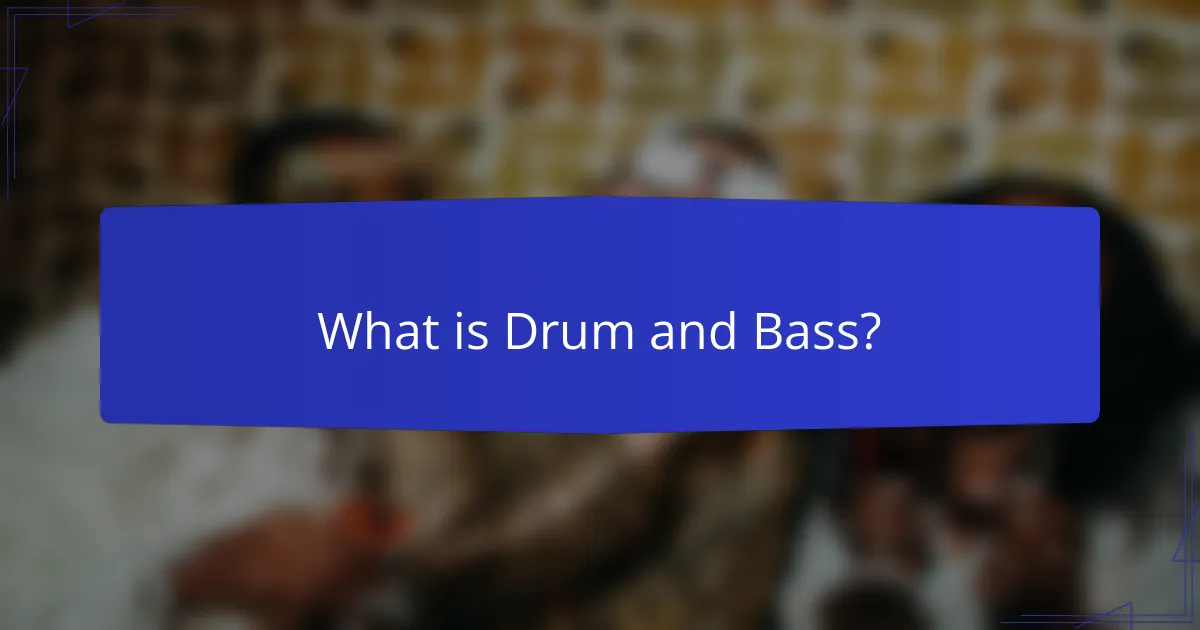
What is Drum and Bass?
Drum and Bass is a genre of electronic music characterized by fast breakbeats and heavy basslines. It originated in the UK during the early 1990s. The tempo typically ranges from 160 to 180 beats per minute. Drum and Bass incorporates elements from various genres, including reggae, hip hop, and jungle. The genre features complex drum patterns and deep sub-bass sounds. Notable subgenres include Liquid, Neurofunk, and Jump-Up. Artists like Goldie and Roni Size have played significant roles in its development. Drum and Bass continues to evolve and influence contemporary music styles.
How did Drum and Bass originate?
Drum and Bass originated in the early 1990s in the United Kingdom. It emerged from the UK rave scene and the jungle music genre. The genre combines fast breakbeats with heavy basslines. Influences include reggae, hip hop, and electronic music. Key producers like Goldie and LTJ Bukem played significant roles in its development. The genre gained popularity through underground clubs and radio stations. By the mid-1990s, it became a dominant force in electronic music. Drum and Bass continues to evolve, spawning numerous subgenres and a global following.
What cultural influences shaped the development of Drum and Bass?
Drum and Bass developed from various cultural influences including reggae, dub, hip-hop, and electronic music. Reggae and dub contributed to its heavy basslines and rhythmic complexity. Hip-hop influenced the sampling techniques and breakbeats used in production. The UK rave scene in the late 1980s and early 1990s played a crucial role in popularizing the genre. Additionally, the multicultural environment of London fostered diverse sounds and styles. Artists like Goldie and Roni Size were pivotal in shaping its mainstream appeal. The genre’s evolution reflects a blend of urban culture and technological innovation in music production.
What are the key characteristics that define Drum and Bass music?
Drum and Bass music is characterized by fast breakbeats and heavy basslines. The tempo typically ranges from 160 to 180 BPM. It often features syncopated drum patterns and deep sub-bass frequencies. Vocals can vary from minimal to heavily processed. The genre incorporates elements from various styles, including reggae, jazz, and hip-hop. It has distinct subgenres like liquid, neurofunk, and jump-up. The production often emphasizes high-energy and danceability. Drum and Bass emerged in the UK during the early 1990s, evolving from jungle music.
What are the essential elements of Drum and Bass?
Drum and Bass is characterized by fast breakbeats and heavy basslines. The tempo typically ranges from 160 to 180 BPM. Breakbeats serve as the rhythmic backbone, often sampled from funk or jazz tracks. Basslines are deep and prominent, frequently utilizing sub-bass frequencies. Synthesizers create atmospheric sounds, adding depth and texture. Vocals may be present, but they are often minimal or manipulated. Drum and Bass features various subgenres, each with unique elements. Notable examples include Liquid, Neurofunk, and Jump-Up.
How does tempo influence the overall sound of Drum and Bass?
Tempo significantly influences the overall sound of Drum and Bass. Typically, Drum and Bass music features a tempo range of 160 to 180 beats per minute. This high tempo creates an energetic and fast-paced rhythm. The rapid beats contribute to the genre’s signature intensity and drive. Additionally, the tempo affects the complexity of breakbeats, allowing for intricate drum patterns. Faster tempos can enhance the sense of urgency in tracks. Conversely, slower tempos within the genre can create a more relaxed atmosphere. Overall, tempo is a critical factor in defining the sound and feel of Drum and Bass music.
What role do basslines play in the composition of Drum and Bass tracks?
Basslines are fundamental in Drum and Bass tracks as they provide the rhythmic and harmonic foundation. They create a sense of movement and energy that drives the track forward. Basslines also establish the genre’s characteristic sound, often featuring deep, sub-heavy tones. This low-frequency emphasis is crucial for creating an immersive listening experience. Additionally, basslines interact with drum patterns to enhance the groove. They help to define the track’s overall mood and intensity. The complexity of basslines can vary, ranging from simple repeated notes to intricate melodic lines. Their role is essential in maintaining listener engagement throughout the track.
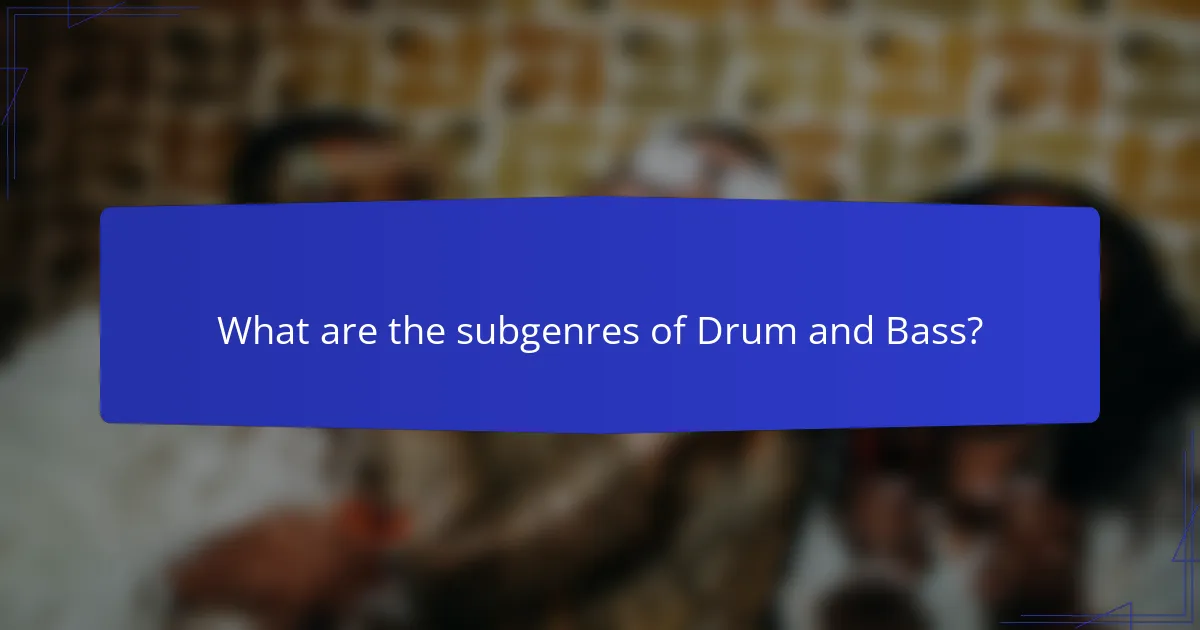
What are the subgenres of Drum and Bass?
Drum and Bass has several prominent subgenres. These include Liquid Drum and Bass, known for its melodic and atmospheric sound. Another subgenre is Neurofunk, characterized by complex basslines and futuristic sounds. Jump Up is energetic and often features heavy bass drops. Darkstep focuses on darker themes and aggressive beats. Lastly, Techstep blends elements of techno with Drum and Bass. Each subgenre offers a unique listening experience, showcasing the diversity within the Drum and Bass genre.
How do different subgenres of Drum and Bass vary?
Different subgenres of Drum and Bass vary primarily in tempo, rhythm, and sound design. For instance, Liquid Drum and Bass features smooth melodies and softer beats, often incorporating jazz and soul influences. In contrast, Neurofunk emphasizes complex basslines and darker soundscapes, creating a more aggressive listening experience. Jump Up focuses on high energy and danceability, with catchy hooks and bass drops. Meanwhile, Techstep incorporates elements of techno, resulting in a more mechanical and minimalistic sound. Each subgenre appeals to different audiences and is characterized by unique production techniques and stylistic choices.
What defines Liquid Drum and Bass compared to other subgenres?
Liquid Drum and Bass is characterized by its smooth, melodic sound and atmospheric elements. Unlike other subgenres, it emphasizes emotional depth and intricate soundscapes. The tempo typically ranges from 160 to 180 BPM, similar to traditional Drum and Bass. However, Liquid incorporates softer basslines and jazz or soul influences. This creates a more laid-back vibe compared to the intensity of Neurofunk or Jump-Up. The use of vocal samples and lush synth pads is common in Liquid tracks. These attributes contribute to a more immersive listening experience. The genre emerged in the late 1990s, with artists like LTJ Bukem leading the way.
What are the unique features of Neurofunk within Drum and Bass?
Neurofunk is a subgenre of Drum and Bass characterized by its intricate, complex basslines and dark atmospheres. The sound design in Neurofunk often incorporates futuristic and sci-fi elements. It features syncopated rhythms, emphasizing off-beat snares and rapid hi-hats. The production quality is typically high, with a focus on detailed layering of sounds. Neurofunk tracks often utilize heavy sub-bass and intricate drum patterns. The genre is known for its use of vocal samples, often manipulated to create eerie effects. Key artists like Noisia and Black Sun Empire are prominent in this subgenre. Neurofunk’s unique features contribute to its distinct identity within the broader Drum and Bass scene.
What are some other notable subgenres of Drum and Bass?
Some notable subgenres of Drum and Bass include Liquid Funk, Neurofunk, and Jump Up. Liquid Funk is characterized by its melodic elements and smooth production. Neurofunk features complex basslines and dark, futuristic sounds. Jump Up is known for its energetic and danceable beats. Each subgenre offers a unique listening experience and showcases the diversity within Drum and Bass music.
How does Jump Up differ from other styles in Drum and Bass?
Jump Up differs from other styles in Drum and Bass by focusing on energetic basslines and catchy melodies. This subgenre emphasizes a more upbeat and danceable rhythm compared to darker styles like Neurofunk. Jump Up tracks often feature prominent, wobbling bass sounds that create an engaging atmosphere. The tempo typically ranges from 160 to 180 BPM, consistent with Drum and Bass norms. Unlike Liquid Drum and Bass, which prioritizes smooth, atmospheric elements, Jump Up is more about high energy and crowd interaction. Its roots can be traced back to the early 2000s, evolving from the UK rave scene. This style is characterized by its playful and sometimes humorous samples, setting it apart from the more serious tones of other subgenres.
What elements characterize Darkstep in the Drum and Bass scene?
Darkstep is characterized by its heavy use of dark, menacing sounds and aggressive basslines. This subgenre often features fast-paced breakbeats and complex drum patterns. Its atmosphere is typically eerie, creating a sense of tension and urgency. Darkstep tracks frequently incorporate samples from horror movies or industrial sounds. The tempo usually ranges between 160 to 180 BPM, maintaining the high energy typical of Drum and Bass. Additionally, the use of distorted and processed vocals is common, enhancing the genre’s dark aesthetic. Notable artists in this genre include Ed Rush and Optical, who have significantly influenced its development.
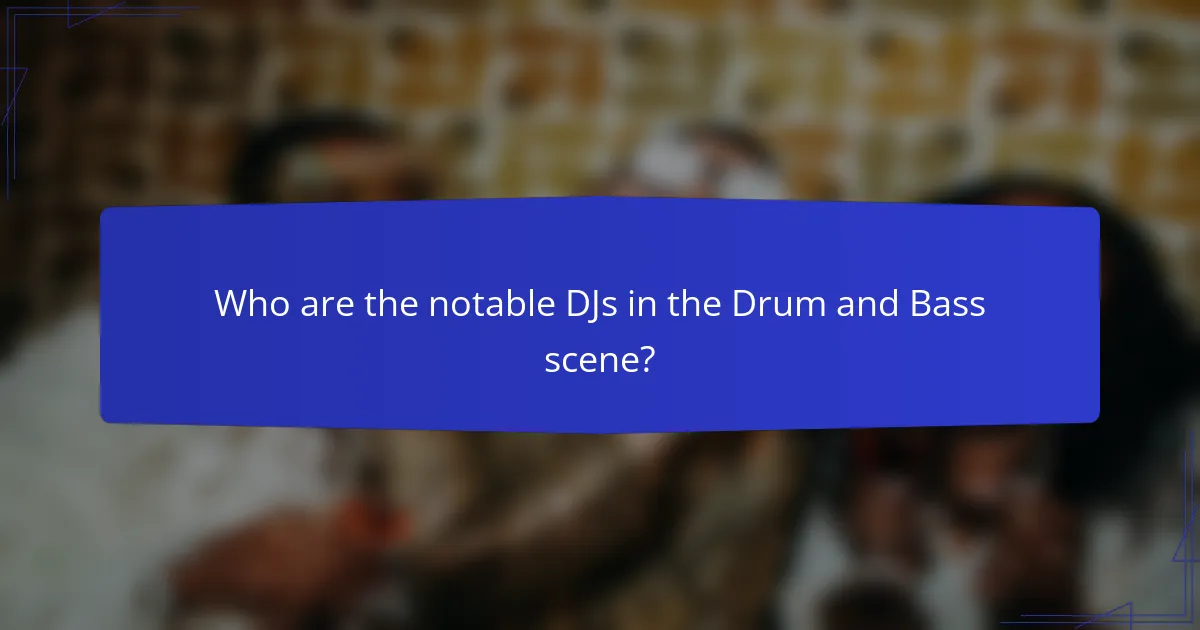
Who are the notable DJs in the Drum and Bass scene?
Notable DJs in the Drum and Bass scene include Andy C, Goldie, and Roni Size. Andy C is renowned for his fast mixing skills and high-energy sets. He has been a pivotal figure in the genre since the 1990s. Goldie is known for his innovative approach and the seminal album “Timeless.” Roni Size gained fame with his album “New Forms,” which won the Mercury Prize in 1997. Other influential DJs include Pendulum, DJ Hype, and LTJ Bukem. Pendulum is recognized for blending live instruments with electronic music. DJ Hype is celebrated for his contributions to the jump-up subgenre. LTJ Bukem is known for his atmospheric sound and pioneering the intelligent drum and bass style. These DJs have significantly shaped the Drum and Bass landscape.
Which DJs are considered pioneers of Drum and Bass?
Goldie, LTJ Bukem, and Andy C are considered pioneers of Drum and Bass. Goldie is known for his album “Timeless,” which showcased the genre’s potential. LTJ Bukem contributed to the atmospheric sound of Drum and Bass with his label Good Looking Records. Andy C is recognized for his exceptional mixing skills and high-energy DJ sets. These artists played significant roles in shaping the genre during the 1990s. Their influence continues to resonate within the Drum and Bass community today.
What contributions did Goldie make to the Drum and Bass genre?
Goldie significantly shaped the Drum and Bass genre through his innovative production and artistic vision. He is known for pioneering the fusion of various musical styles, including jazz, classical, and hip-hop, into Drum and Bass. His debut album, “Timeless,” released in 1995, is widely regarded as a landmark in the genre. This album introduced orchestral elements and complex arrangements, elevating the sound of Drum and Bass. Goldie’s work also popularized the use of breakbeats and deep basslines, which became defining characteristics of the genre. Furthermore, he played a crucial role in bringing Drum and Bass to a broader audience through his performances and collaborations. His influence can be seen in the works of many contemporary artists within the genre.
How has Andy C influenced the evolution of Drum and Bass music?
Andy C has significantly influenced the evolution of Drum and Bass music through his innovative techniques and performances. He is known for his exceptional mixing skills and energetic DJ sets. His ability to blend various subgenres has pushed the boundaries of the genre. Andy C popularized the use of double drop mixing, which creates a dynamic listening experience. He has also been instrumental in promoting new talent within the scene. His label, RAM Records, has launched numerous successful artists. Additionally, he has headlined major festivals, bringing Drum and Bass to wider audiences. His impact is evident in the genre’s growth and global reach.
What are the current leading DJs in the Drum and Bass community?
The current leading DJs in the Drum and Bass community include Andy C, Goldie, and Noisia. Andy C is renowned for his energetic sets and technical skills. He has been a pivotal figure in the genre since the early 1990s. Goldie, a pioneer of the genre, is known for his influential album “Timeless.” Noisia, recognized for their innovative production, has significantly impacted the sound of Drum and Bass. Other notable names include Pendulum, Friction, and High Contrast. These DJs consistently draw large crowds and are influential in shaping the Drum and Bass scene today.
What sets DJ Hype apart in the contemporary Drum and Bass scene?
DJ Hype is distinguished in the contemporary Drum and Bass scene by his innovative mixing techniques and contributions to the genre. He is known for his ability to blend various subgenres seamlessly. DJ Hype has been a pivotal figure since the 1990s, helping to shape the sound of jump-up Drum and Bass. His energetic performances and unique track selection set him apart from other DJs. He also co-founded the influential label Ganja Records, which has launched numerous successful artists. DJ Hype’s extensive experience and dedication to the craft have earned him a loyal following. His influence is evident in the evolution of Drum and Bass music today.
How has Wilkinson impacted the popularity of Drum and Bass globally?
Wilkinson has significantly enhanced the global popularity of Drum and Bass through his innovative sound and mainstream collaborations. His hit single “Afterglow” achieved chart success, reaching number 8 in the UK Singles Chart in 2013. This track introduced the genre to a broader audience, blending accessible melodies with classic Drum and Bass elements. Wilkinson’s performances at major music festivals, such as Glastonbury and Reading and Leeds, have also showcased the genre to diverse crowds. His ability to collaborate with artists from various genres further bridges the gap between Drum and Bass and mainstream music. This cross-genre appeal has attracted new fans and revitalized interest in Drum and Bass on a global scale.
What tips can help you appreciate Drum and Bass music more?
To appreciate Drum and Bass music more, immerse yourself in its subgenres. Explore Liquid, Neurofunk, and Jump Up styles for diverse experiences. Attend live performances to feel the energy and connect with the community. Listen actively to understand complex rhythms and basslines. Familiarize yourself with influential DJs and producers like Goldie and Andy C. Study the history of Drum and Bass to grasp its evolution and cultural significance. Engage with online forums to discuss tracks and share recommendations. Lastly, create playlists that highlight your favorite songs to deepen your connection.
How can understanding the structure of Drum and Bass enhance your listening experience?
Understanding the structure of Drum and Bass enhances your listening experience by allowing you to appreciate its intricate layers. This genre typically features a fast-paced rhythm, often around 160-180 BPM. Recognizing the elements like the breakbeat, bassline, and melodic components helps listeners identify key transitions.
Drum and Bass often employs a build-up and drop structure, creating tension and release. Knowing when these moments occur can heighten emotional responses. Additionally, understanding subgenres, such as Liquid or Neurofunk, informs listeners about varying styles and soundscapes.
This knowledge makes it easier to connect with the music on a deeper level. Engaging with the genre’s complexity can lead to a more fulfilling auditory experience. Overall, comprehension of its structure enriches enjoyment and appreciation of Drum and Bass.
What are the best ways to explore new Drum and Bass tracks and artists?
The best ways to explore new Drum and Bass tracks and artists include using streaming platforms, attending live events, and following music blogs. Streaming platforms like Spotify and SoundCloud provide curated playlists and recommendations based on listening habits. Live events, such as club nights and festivals, showcase emerging talent and popular DJs. Music blogs and websites often feature reviews and interviews, offering insights into new artists. Social media platforms allow fans to connect directly with artists and discover new releases. Online communities and forums dedicated to Drum and Bass can also provide recommendations and discussions about new tracks.
Drum and Bass is an electronic music genre known for its fast breakbeats and heavy basslines, originating in the UK in the early 1990s. The article explores its cultural influences, key characteristics, and essential elements, including the role of tempo and basslines in shaping its sound. It also examines various subgenres such as Liquid, Neurofunk, and Jump-Up, highlighting their unique features and differences. Notable DJs and pioneers like Goldie, Andy C, and Roni Size are discussed for their significant contributions to the genre, along with tips for appreciating and exploring new Drum and Bass music.
